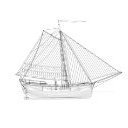
Bob Cleek
-
Posts
3,374 -
Joined
-
Last visited
Reputation Activity
-
 Bob Cleek reacted to Jaager in Byrnes saw fence advice sought
Bob Cleek reacted to Jaager in Byrnes saw fence advice sought
As you do this, think about the physics of the operation.
The plane of the cutting teeth and the plane of the fence must be parallel up thru the zone of active cutting.
The part of the blade behind that is an encumbrance. It is a source of friction, A blade that is hollow ground or whose teeth have set can greatly reduce the friction.
Hollow ground is more expensive, There is an outer ring in the zone with the teeth that is not ground. We are usually cutting stock that is so thin that some or all of it is still at the flat part. We loose the advantage that the hollow provides.
Blades with significant set also have significant lose to kerf.
If the fence has off set THAT IS LIMITED to the part that is behind the crown of the blade will reduce the friction. But, to do this, the fence must have two planes and must have special engineering.
If the product being cut comes out between the fence and the blade, once the settings are precise and accurate, you can rock and roll forever. There is just kick back and pushing it all behind the blade to worry about.
If the thin rip guide is used, there is no kick back and the push is easy. The fence must be moved after every cut, so no rock and roll. But a micrometer is not needed to reposition the fence. The surface of the stock that rides against the fence does not change with every cut.
Another factor but not a part of this problem is that the ideal is that the blade be one with three teeth in the thickness of the stock being cut.
-
 Bob Cleek reacted to rwiederrich in Glory of the Seas 1869 by rwiederrich - FINISHED - 1/96 - medium clipper
Bob Cleek reacted to rwiederrich in Glory of the Seas 1869 by rwiederrich - FINISHED - 1/96 - medium clipper
Thanks Bob. I knew I would always regret not correcting this error. If I’m to be extremely particular about so much correct detail……..I couldn’t be a hypocrite concerning this error.
You’ve always been an accuracy buff where I’m concerned and I know you wouldn’t have me act any differently.
Now I can see clearly the correct forecastle deck location. As it should be.
Rob
-
 Bob Cleek got a reaction from Dave_E in Glory of the Seas 1869 by rwiederrich - FINISHED - 1/96 - medium clipper
Bob Cleek got a reaction from Dave_E in Glory of the Seas 1869 by rwiederrich - FINISHED - 1/96 - medium clipper
Good on you, my man! This must have been a great disappointing frustration, but your commitment to accuracy is to be highly commended. Great work so far and I'm sure you'll never regret this correction!
-
 Bob Cleek reacted to wefalck in Knots to Use (or not!) in Rigging
Bob Cleek reacted to wefalck in Knots to Use (or not!) in Rigging
Knots and hitches are only used to temporarly fasten a line. In most cases eye-splices are used or seizings, when the rope would be too stiff to tie a knot or a splice would weaken it (as in the example above of the breech-rope).
There are many specialised knots/hitches, but depending on the scale, they may be difficult to tie. In most cases I seem to get away with half- and clove-hitches, if required.
A real splice would be a challange at most scales, but fake splices are easy to do.
Personally, I prefer a fast-drying clear solvent-based varnish for securing rigging, as it can be easily softened with the solvent, if needed.
-
 Bob Cleek reacted to rwiederrich in Glory of the Seas 1869 by rwiederrich - FINISHED - 1/96 - medium clipper
Bob Cleek reacted to rwiederrich in Glory of the Seas 1869 by rwiederrich - FINISHED - 1/96 - medium clipper
Well here we go. …….. demolition time. First to remove all the furniture and hardware.
-
 Bob Cleek reacted to KeithAug in Germania Nova 1911 by KeithAug - FINISHED - Scale 1:36 - replica of schooner Germania 1908
Bob Cleek reacted to KeithAug in Germania Nova 1911 by KeithAug - FINISHED - Scale 1:36 - replica of schooner Germania 1908
Thank you Pat and Keith.
A bit of time was spent on the dinghy over the weekend.
I started with a few coats of thin enamel paint with sanding between coats.
Then I did a bit of masking and applied black paint to rowlocks and oar clips and shades of grey to the bumpers, deck and solid bottom.
Anti- slip strips were required for the deck - made from sail repair tape blackened with permanent marker.
Grab handles were needed on the sides and I made a drilling jig out of a piece of aluminium tube to get the attachment holes correctly spaced.
Fabric reinforcing was cut from sail tape.
This was also coloured and applied.
The handles themselves were made from flattened .031" wire. These were attached and painted black.
A further bit of anti-slip matting was attached to the locker and the oars were glued permanently in place. 3 black inflation valves were also added.
-
 Bob Cleek reacted to Egilman in USS New Jersey by popeye the sailor - Tamiya - 1:350 scale - PLASTIC
Bob Cleek reacted to Egilman in USS New Jersey by popeye the sailor - Tamiya - 1:350 scale - PLASTIC
Finials...
Google
Or, in the alternative, the lamp hardware section of any big box store
-
 Bob Cleek got a reaction from mikiek in Storage and transportation
Bob Cleek got a reaction from mikiek in Storage and transportation
Owning a motorhome myself, I'd expect that the road vibrations wouldn't be conducive to long model life. I suppose your mileage may vary, but the guys who built my motorhome obviously had no regard whatsoever for the long-term effects of vibration.
-
 Bob Cleek got a reaction from Dave_E in Storage and transportation
Bob Cleek got a reaction from Dave_E in Storage and transportation
Owning a motorhome myself, I'd expect that the road vibrations wouldn't be conducive to long model life. I suppose your mileage may vary, but the guys who built my motorhome obviously had no regard whatsoever for the long-term effects of vibration.
-
 Bob Cleek got a reaction from Canute in Storage and transportation
Bob Cleek got a reaction from Canute in Storage and transportation
Owning a motorhome myself, I'd expect that the road vibrations wouldn't be conducive to long model life. I suppose your mileage may vary, but the guys who built my motorhome obviously had no regard whatsoever for the long-term effects of vibration.
-
 Bob Cleek reacted to Roger Pellett in Storage and transportation
Bob Cleek reacted to Roger Pellett in Storage and transportation
If you are going to put the time and effort into building a ship model you should plan to build or buy a case for it. Over the years I have built 10 or so glass cases for my models and have come up with a standardized design. When we moved from Southeastern Ohio to Northeastern Minnesota the movers put my cased models into regular cardboard moving boxes. There was no damage to any models when the were unpacked at the new destination.
Roger
-
 Bob Cleek got a reaction from Canute in High torque, really low speed drill
Bob Cleek got a reaction from Canute in High torque, really low speed drill
The relationship between speed and torque is a function of the motor design. Inexpensive motors can make up for their inherent lack of heavier (and more costly) construction by using speed to make up for a lack of torque. Hence, when their speed is reduced, so is their torque, often to the point where at lower speeds they stall out. A heavy-duty electric motor can be built to maintain torque at low speeds, but the construction costs more. These will generally be tools like the Foredom flex-shaft and belt-driven dental engines.
-
 Bob Cleek got a reaction from EricWilliamMarshall in High torque, really low speed drill
Bob Cleek got a reaction from EricWilliamMarshall in High torque, really low speed drill
The relationship between speed and torque is a function of the motor design. Inexpensive motors can make up for their inherent lack of heavier (and more costly) construction by using speed to make up for a lack of torque. Hence, when their speed is reduced, so is their torque, often to the point where at lower speeds they stall out. A heavy-duty electric motor can be built to maintain torque at low speeds, but the construction costs more. These will generally be tools like the Foredom flex-shaft and belt-driven dental engines.
-
 Bob Cleek got a reaction from Brinkman in High torque, really low speed drill
Bob Cleek got a reaction from Brinkman in High torque, really low speed drill
The relationship between speed and torque is a function of the motor design. Inexpensive motors can make up for their inherent lack of heavier (and more costly) construction by using speed to make up for a lack of torque. Hence, when their speed is reduced, so is their torque, often to the point where at lower speeds they stall out. A heavy-duty electric motor can be built to maintain torque at low speeds, but the construction costs more. These will generally be tools like the Foredom flex-shaft and belt-driven dental engines.
-
 Bob Cleek got a reaction from No Idea in High torque, really low speed drill
Bob Cleek got a reaction from No Idea in High torque, really low speed drill
The relationship between speed and torque is a function of the motor design. Inexpensive motors can make up for their inherent lack of heavier (and more costly) construction by using speed to make up for a lack of torque. Hence, when their speed is reduced, so is their torque, often to the point where at lower speeds they stall out. A heavy-duty electric motor can be built to maintain torque at low speeds, but the construction costs more. These will generally be tools like the Foredom flex-shaft and belt-driven dental engines.
-
 Bob Cleek got a reaction from mtaylor in High torque, really low speed drill
Bob Cleek got a reaction from mtaylor in High torque, really low speed drill
The relationship between speed and torque is a function of the motor design. Inexpensive motors can make up for their inherent lack of heavier (and more costly) construction by using speed to make up for a lack of torque. Hence, when their speed is reduced, so is their torque, often to the point where at lower speeds they stall out. A heavy-duty electric motor can be built to maintain torque at low speeds, but the construction costs more. These will generally be tools like the Foredom flex-shaft and belt-driven dental engines.
-
 Bob Cleek got a reaction from bruce d in High torque, really low speed drill
Bob Cleek got a reaction from bruce d in High torque, really low speed drill
The relationship between speed and torque is a function of the motor design. Inexpensive motors can make up for their inherent lack of heavier (and more costly) construction by using speed to make up for a lack of torque. Hence, when their speed is reduced, so is their torque, often to the point where at lower speeds they stall out. A heavy-duty electric motor can be built to maintain torque at low speeds, but the construction costs more. These will generally be tools like the Foredom flex-shaft and belt-driven dental engines.
-
 Bob Cleek reacted to No Idea in High torque, really low speed drill
Bob Cleek reacted to No Idea in High torque, really low speed drill
Cooks on gold sell them in the UK that’s where I got mine from. I’m unsure though why you think RPM has anything to do with torque? The motors that Foredom supply are very powerful and I’ve never been able to stall mine. Even at really low speed the power is there and I think mine is an SR.
-
 Bob Cleek reacted to No Idea in High torque, really low speed drill
Bob Cleek reacted to No Idea in High torque, really low speed drill
Hi - I’ve got the foredom drill and although they are expensive it’s probably what you are looking for. It has a foot control so you can go as slow as you like. It also has loads of torque and I cannot compare it to my old dremel.
Mark
-
 Bob Cleek reacted to rwiederrich in dead eye twist
Bob Cleek reacted to rwiederrich in dead eye twist
AND don't forget to use dark thread...or black for the lanyards. They are just as much part of the standing rigging as is the shroud above.
Rob
-
 Bob Cleek reacted to Dr PR in Dremel rotary tool?
Bob Cleek reacted to Dr PR in Dremel rotary tool?
I have an ancient (1970s) small Dremel Model 260 (they used to make two sizes) corded tool. It isn't the greatest but it works - heats up quickly. I also have their motor speed control, and like everyone has said it has low torque at low speeds.
I do occasionally use it in the old (piece of junk) drill stand to mill various wooden shapes - such as cannon carriages. I also use this rig as a drill press to locate drilled hole more precisely than I can accomplish by hand with the Dremel or a pin vise.It is a test of my patience but it does work.
But one of the best uses is cleaning up soldered joints. The steel wire brush at medium speeds will remove excess solder much better than a file or sand paper. But you have to be careful to not remove too much!
The wire brushes can also be used to shine metal prior to soldering, blackening or painting.
The low torque at low speeds is an advantage when working with wood, because at high speed it is very aggressive and can eat through softer woods very quickly. I sometimes use it to rough out wood prior to carving with knives and files.
I also have used it as a poor man's lathe, but I also use a variable speed hand drill for this function.
SO it is a useful modeling tool for a variety of operations. But I do use pin vises mostly for drilling holes.
-
 Bob Cleek reacted to Landlubber Mike in Dremel rotary tool?
Bob Cleek reacted to Landlubber Mike in Dremel rotary tool?
I agree with Bob above. I rarely use my Dremel, but did use if for things like shaping filler blocks. A couple of years ago I bought a Nakajima micromotor at the suggestion of another member here. They are not cheap, but it's an amazing tool. You have so much more control over the tool, not only speed wise, but from the stylus (not sure what the rotary component is called) which is incredibly light and with zero vibration and the use of a foot pedal. I find myself using it a lot in plastic modeling, and can see myself using it when I get back to working with wood models.
I use it to drill holes, file sections down, sand, use cut-off wheels, and more. It's not that a Dremel can't do it, you just have a lot more control with a micromotor like the Nakajima.
-
 Bob Cleek reacted to mtaylor in Dremel rotary tool?
Bob Cleek reacted to mtaylor in Dremel rotary tool?
I'll qualify my post above Bob's... I always try to use the lowest possible speed on any rotary hand tool. If' there's not enough torque, I'm using too much pressure.
-
 Bob Cleek got a reaction from Landlubber Mike in Dremel rotary tool?
Bob Cleek got a reaction from Landlubber Mike in Dremel rotary tool?
I've owned several Dremel mototools and their equivalents over the decades and have always found them a very handy tool to have around. That said, for modeling purposes, as Roger noted above, it is not a tool for delicate work. It's major drawback in this respect is that it relies upon speed, rather than torque, to get the job done and the lower their speed, the lower their torque. High speed tools are difficult to control. In my experience, anybody who stays with miniature work for any length of time ends up acquiring a Foredom flex-shaft rotary tool or a bench-top belt-driven laboratory dental engine after being at it a while. These foot pedal controlled alternatives have much more torque, even at low speeds. As always, "the good stuff' costs more, but you get what you pay for and you only have to buy a good tool once in a lifetime (unless you make the mistake of loaning your tools!) Fortunately for modelers, the dental laboratory industry has been transitioning to "micro-motor" and air turbine-driven handpieces in recent years, so there are good condition used Foredom flex-shafts and dental lab engines to be had on the used market these days at a fraction of their original cost.
This YouTube video is very informative:
-
 Bob Cleek got a reaction from mtaylor in Dremel rotary tool?
Bob Cleek got a reaction from mtaylor in Dremel rotary tool?
I've owned several Dremel mototools and their equivalents over the decades and have always found them a very handy tool to have around. That said, for modeling purposes, as Roger noted above, it is not a tool for delicate work. It's major drawback in this respect is that it relies upon speed, rather than torque, to get the job done and the lower their speed, the lower their torque. High speed tools are difficult to control. In my experience, anybody who stays with miniature work for any length of time ends up acquiring a Foredom flex-shaft rotary tool or a bench-top belt-driven laboratory dental engine after being at it a while. These foot pedal controlled alternatives have much more torque, even at low speeds. As always, "the good stuff' costs more, but you get what you pay for and you only have to buy a good tool once in a lifetime (unless you make the mistake of loaning your tools!) Fortunately for modelers, the dental laboratory industry has been transitioning to "micro-motor" and air turbine-driven handpieces in recent years, so there are good condition used Foredom flex-shafts and dental lab engines to be had on the used market these days at a fraction of their original cost.
This YouTube video is very informative:



.thumb.jpeg.fc5d633a7b34428fcf19419a73d56d55.jpeg)




